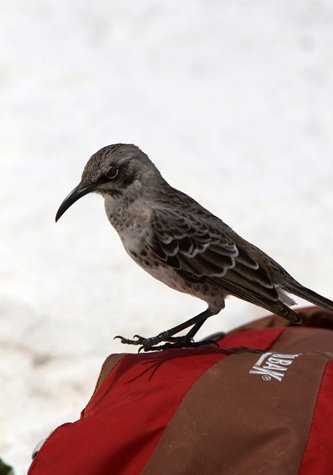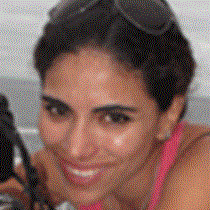Our first sunrise in Galapagos was beautiful. We were anchored off Gardner Beach, one of the most spectacular white coral sand beaches in Galapagos, with an impressive colony of Galapagos sea lions. The air was a bit chilly, water temperature 68.5F, but sunny and calm. The conditions were perfect to enjoy an early kayak outing along the shores of Española. Blue footed boobies were here and there while sea lions followed some kayakers and sea turtles were popping their heads out of the water. After a good forty minute kayak outing, it was time to go back on board for breakfast. Soon after that, Lynn, our expedition leader, was giving the safety briefing as we were sorting out all the snorkel equipment. With everybody already geared up with their best snorkel outfits, some of us headed out for the deep water option off Gardner Islet, while others went to the beach either to swim, relax or just learn how to use the gear.
The deep water snorkel was very good. The water was a little chilly, but it was worth it! Plenty of fish, yellow tailed razors, damsels, rainbow wrasses, some rays, a solitary white tip reef shark and a couple of playful sea lions that stayed with us for a while playing – the sort of thing that make our islands so unique and special.
Back to the ship, hot chocolate and cookies were waiting for us and immediately we put on our dry clothes and headed to the beach to spend some time with the sea lions and enjoy the beautiful scenery of the site. The colors were wonderful: turquoise water, black lava rocks, white sand and some green patches of vegetation.
Lunch was a feast of Ecuadorian food: “ceviche“ of fish, squid and octopus, encocado de pescado (fish with coconut milk), hornado (roasted suckling pig), llapingachos (potato patties with peanut sauce), assorted salads and the famous desserts: postre de la tres leches (three milk cake), helado de naranjilla (naranjilla sorbet) and alfajores (cookies with caramel cream). And of course after such a meal, siesta time!
At 3:30 p.m. we were ready to explore the other side of the Island, a place named Punta Suarez, famous for the abundance of endemic species only found in this island, such as the Española lava lizard, the endemic snake
(Española racer), the Española mockingbird and the always outstanding waved albatross, among other species such as 3 of the 14 different species of Darwin finches, Galapagos doves, the Galapagos hawk, blue footed boobies and Nazca boobies.
Baby sea lions where everywhere at the disembarkation area, among piles of the distinctive marine iguanas with red colors, while waved albatross were soaring through the air and Nazca boobies and blue footed boobies were either courting, taking care of their babies or busy building their nests.
By the end of this amazing day, we finally understood how lucky we were, as we had the chance to see species that not even Darwin saw while he visited the islands back in 1835, as he never visited Española. But, thanks to him and his incredible observations of nature 179 years ago, today we were able to better understand the origin of species and how natural selection and evolution work.









